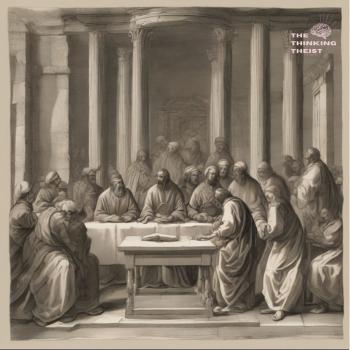Editor’s Note: I’m in Miami at the Faith Angle Forum, where today I’m listening to Tim Keller speak on the future of American evangelicalism. I look forward to writing all about it soon. Below is a guest post from my friend Ammon Simon, an attorney focused on constitutional issues with the Judicial Crisis Network.
*
The DOJ and the Life of Julia
By Ammon Simon
The Obama Administration’s Department of Justice has been on the frontlines of an assault on religious freedom and intermediary institutions, showing disrespect for the First Amendment and a proclivity for big government that even the Clinton Administration would not have dared approach. From targeting churches and their hiring practices, to attacking pro-lifers and attempting to marginalize certain societal institutions from the public arena, the DOJ has used the full force of its national enforcement power to implement a far-reaching, government-centric agenda.
Understanding the full destructive power of this attack on the First Amendment requires a philosophical context: President Obama’s apparent belief, at least in practice, in government as the source of All Good Things. One need look no further than his disturbing Life of Julia ad, which followed a woman whose only significant and enduring relationship was that between her and the state apparatus; her life’s only assistance came from government programs. President Obama’s inauguration speech also echoed this theme, sounding like, as Charles Krauthammer put it, “the perfect homily for the marriage of Julia…and the state,” and “an ode to the collectivity.”
This is particularly true of the president’s conception of religious freedom. Instead of endorsing the full spectrum of religious freedom, the President gravitates toward merely protecting freedom of worship, which amounts essentially to what happens in a church. Under this view, as Carrie Severino has argued, “the Constitution should only protect a dead faith that is free of works,” making religious freedom inapplicable when your faith pushes you to step outside your church’s four walls, and penalizing those religious institutions that do.
The HHS abortion pill mandate is a perfect example of this distinction, where the Obama Administration exempted only a narrow band of religious institutions from the abortion pill mandate, leaving other conscientious objectors including bible publishers and Christian colleges as well as individual business owners out to dry.
Fighting this government-centric worldview’s appeal requires a more compelling alternative vision of society for the less fortunate, a vision that cannot cohere together without robust societal institutions. Patrick Garry in “Conservatism Redefined: A Creed for the Poor and Disadvantaged” argues that society also “involve[s] a vast array of private institutions like religions and families and volunteer associations” (p. 23). Echoing Alexis de Tocqueville, he explains that these institutions “provide the moral and spiritual supports necessary to ensure the healthy functioning of a stable democratic order…” (p. 39). Government certainly has a role in providing for certain material needs, but by definition that role is constrained. Intermediary institutions are much more effective at injecting people into the daily lives of the needy, creating long-term transformation, instead of short-term fulfillment.
Unfortunately, President Obama’s government-centric philosophy undercuts these essential parts of society, religious and not, that have historically served as more-effective alternatives to centralized government and its legion of bureaucrats. The DOJ is at the forefront of these efforts, as the following examples make clear.
Hosanna Tabor v. EEOC
This case involved the ministerial exception, which shields religious institutions from liability for violating employment laws for “ministerial” hires. For example, it would shield conservative churches from liability for not hiring female head pastors. The DOJ took such an extreme position — completely rejecting the ministerial exception except in, at best, a very narrow band of cases — that Justice Roberts’ unanimous opinion characterized it as the “remarkable view that the Religion Clauses have nothing to say about a religious organization’s freedom to select its own ministers.” The DOJ’s position would have implicated churches who maintain a male priesthood, exposing them to a multitude of new discrimination claims. This position went too far for leftist groups such as ACLU and Americans United for Separation of Church and State, and even Justice Kagan found it to be “amazing.” If the DOJ had been successful, crippling fines would have forced some churches to either shut down or compromise on core elements of their faith. Thankfully, a unanimous Supreme Court opinion rejected the DOJ’s extreme efforts to gut religious freedom.
Abortion
The Department of Justice has been targeting and intimidating peaceful pro-life activists, stepping into realms ordinarily reserved for advocacy organizations like the ACLU, not our nation’s law enforcement. Their efforts center on the Freedom of Access to Clinic Entrance Act, which prohibits, in part, the use or threat of force or physical obstruction to prevent a person from obtaining reproductive services. While enforcing legitimate violations of the FACE act is understandable, the DOJ’s far-reaching enforcement of the FACE act targets the legitimate free speech of activists, while undermining societal institutions that work outside of government channels to reduce abortion.
For a long time, Democrats approached this issue following Bill Clinton’s formulation of “safe, legal, and rare.” Then-Senator Hillary Clinton saw abortion as a “sad, even tragic choice to many, many women,” and called for government to “do more to educate and inform and provide assistance” so that abortion would become either rare or non-existent. This still represents a majority public opinion. A 2012 Gallup poll found that only 41% of respondents believed that abortion should be “legal under any” or “most” circumstances,” while 56% believed that abortion should be “legal only in few” or no circumstances.
Supporters of the Clinton formulation should support the work of pro-life activists, who view abortion as more than just a tragic choice. They are responsible for thousands of women deciding to take their babies to term, and use education — not coercion — to make “rare” a reality. As long as they avoid actions that the FACE Act legitimately proscribes — such as violence or interference with private property — there is no reason why pro-lifers should fall under law enforcement scrutiny. Not for the Holder-led DOJ though, as four disturbing cases make clear.
One of the most egregious cases is Holder v. Pine. There, District Court Judge Ryskamp dismissed a baseless FACE lawsuit against Mary Pine, a pro-life advocate, whose only “crime” appeared to be handing out literature and motioning at cars, not stopping them or persisting in unwanted efforts. In dismissing the suit, Judge Ryskamp even felt compelled to speculate that the suit could be the result of explicit coordination between the DOJ and the abortion clinic “to quell Ms. Pine’s activities rather than to vindicate the rights of those allegedly aggrieved by Ms. Pine’s conduct.” He explained that the “record [was] almost entirely devoid of evidence” supporting the DOJ, and he was “at a loss as to why the Government chose to prosecute this particular case in the first place.” The lawsuit was so frivolous that the DOJ paid a $120,000 fine and dropped the lawsuit.
Elsewhere, in Holder v. Hamilton, the DOJ intimidated David Hamilton, a pro-life sidewalk counselor, into accepting a $2,500 settlement rather than face as high as $20,000 in penalties and damages. In the incident in question, Hamilton had broken the arm-lock of two clinic escorts who were trying to prevent him from lawfully talking with women entering the clinic. Even though the clinic escorts appeared to be in the wrong, and Hamilton had not threatened or intimidated women, the DOJ still wielded the FACE act against him.
The DOJ dropped a similar case against Denver resident Ken Scott. The DOJ had speciously argued that momentarily delaying cars from entering from abortion clinic — in an effort to talk to their occupants — was a sufficient obstruction to an abortion to warrant a federal lawsuit. As Scott’s attorney, Peter Breen, explained, “[t]here…[was] no allegation of physical violence, there was no allegation of trespassing…He was merely offering assistance to men and women who were entering Planned Parenthood.” Just as the DOJ might have worked in concert with the abortion clinic in Pine, here the DOJ had built its case upon complaints from Planned Parenthood employees, risking its credibility with the judge, who ruled in a preliminary injunction that the case was unlikely to succeed on its merits.
Finally, the DOJ recently settled a case against Dick Retta, dropping their initial request for $15,000 in damages and penalties, securing instead an injunction against Retta’s presence at an abortion clinic. Retta, who is affectionately described as a pro-life grandpa, is thought to have been responsible for as many as 1,000 abortion “saves” since around 1997. Not surprisingly, this made Retta, who himself instructs sidewalk counselors to allow patients clinic access, a target for clinic workers. As in other cases, Retta does not appear to have done anything that would have triggered a legitimate violation of the FACE act. It even appears that one allegation against Retta originated from when a clinic volunteers stymied a young girl’s attempt to reach out to him, and he pleaded “with the girl to not let the escorts force her to have an abortion.”
Heightened scrutiny for sexual orientation
The DOJ has been advocating for heightened scrutiny for sexual orientation in court, a change that would be disastrous for religious institutions.
Courts subject laws to heightened scrutiny if they distinguish based on factors such as race or gender, making them much more likely to strike down such a law. Gender receives a middle level of scrutiny, intermediate scrutiny, while race receives the highest level of scrutiny, strict scrutiny. Strict scrutiny almost always results in a law’s invalidation, and intermediate scrutiny has a similar, if less-pronounced, track record. For example, in Bob Jones University v. United States, the Supreme Court invoked strict scrutiny to revoke a college’s tax-exempt status for banning interracial dating and marriage, while in VMI v. Virginia, the Supreme Court invoked intermediate scrutiny to order a state-run male-only military academy to admit females.
The DOJ has advocated for heightened scrutiny for sexual orientation since February 2011, when it refused to defend Section 3 of the Defense of Marriage Act. The DOJ has also argued for heightened scrutiny in the two pending Supreme Court same-sex marriage cases, U.S. v. Windsor and Hollingsworth v. Perry.
Heightened scrutiny would create a tidal wave of lawsuits against religious institutions that receive tax-exempt status, federal funding, or similar federal benefits, treating them like racists under the law for objecting to homosexual conduct. This could implicate hiring practices, admissions policies, and religious doctrine. Certain organizations could have to relinquish their religious character or operate in the shadows under increasing costs. Religious schools, such as my alma mater, Wheaton College (IL), could lose their tax-exempt status — as in Bob Jones — or access to federal student loans. This new regime could also ban state licensing of religiously motivated adoption agencies (lest government condone unconstitutional discrimination), or force other religious charities and hospitals to shut down or lose eligibility for government money. Even if some religious institutions remained unscathed, their survival would come at a steep litigation cost.
Many on the left cannot understand why coercing religious institutions to embrace their version of tolerance and diversity would be so destructive. In their mind, the DOJ should use its monopoly on force against discriminatory institutions, as it did for racist institutions in the twentieth century. They also believe that the left’s sexual ethics should override “antiquated” religious conceptions of morality. However, even from that perspective, pragmatically, society is much worse off without these institutions. The purging of various societal institutions from the public arena would create a less diverse society, leading to fewer options for people of faith and less hope for the poor. The inevitable result is a larger role for a centralized, faceless, far-off government.
Thankfully, there is hope throughout all of these attacks on societal institutions. At least some courtrooms have rejected the DOJ’s targeting of pro-life activists, and the Supreme Court, in Hosanna Tabor, handed the DOJ an embarrassing loss. However, the biggest stakes could come up this term, as the Supreme Court could grant in either Windsor or Hollingsworth if sexual orientation should receive heightened scrutiny. Although no one can know likely swing vote Justice Kennedy’s thoughts, hopefully he will realize the disastrous consequences of following the Justice Department’s lead on religious liberty.
*
Ammon Simon is policy counsel at the Judicial Crisis Network and a former assistant attorney general of Missouri.
















